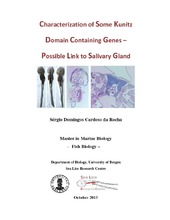| dc.contributor.author | Cardoso da Rocha, Sérgio Domingos | |
| dc.date.accessioned | 2016-01-15T17:07:13Z | |
| dc.date.available | 2016-01-15T17:07:13Z | |
| dc.date.issued | 2015-10-15 | |
| dc.date.submitted | 2015-10-15 | eng |
| dc.identifier.uri | http://hdl.handle.net/1956/10973 | |
| dc.description.abstract | As a hematophagous parasite, anticoagulants are crucial for L. salmonis. In hematophagous animals specific anticoagulants are produced by salivary gland in order to keep the blood liquid and to allow the parasite to process it properly. Such proteins are unknown in L. salmonis as well as its site of expression. At the same time the function of the salivary gland as production of anticoagulant factors has not been confirmed in L. salmonis. Genes with Kunitz domain are typically proteinase inhibitors and some are involved in anticoagulation. They are present in L. salmonis but with unknown function and site of expression. This studied demonstrated the presence of two salivary gland specific genes belonging to the Kunitz family and other highly expressed in the intestine. The silencing of these genes did not give any distinct phenotypes in adults or larvae stages. The present study could not conclude if the three investigated genes are involved in anticoagulation in the salmon louse. However, the lack of detectable phenotypes in the RNAi experiments indicates that could be other compensating molecules in the lice for the processes that LsKunitz1-3 are involved in. | en_US |
| dc.format.extent | 2098754 bytes | eng |
| dc.format.mimetype | application/pdf | eng |
| dc.language.iso | eng | eng |
| dc.publisher | The University of Bergen | en_US |
| dc.title | Characterization of some Kunitz domain containing genes - possible link to Salivary gland | en_US |
| dc.type | Master thesis | |
| dc.rights.holder | Copyright the Author. All rights reserved | en_US |
| dc.description.localcode | MAMN-MAR | |
| dc.description.localcode | MAR399 | |
| dc.subject.nus | 751599 | eng |
| fs.subjectcode | MAR399 | |
